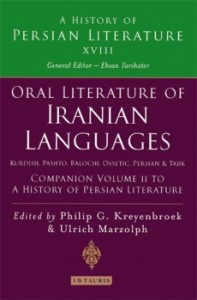Posted on June 9th, 2012 by Administrator
 Oral Literature of Iranian Languages Oral Literature of Iranian Languages
Kurdish, Pashto, Balochi, Ossetic,
Persian and TajikIn the 1990s I gradually became convinced that the time had come for a new, comprehensive, and detailed history of Persian literature, given its stature and significance as the single most important accomplishment of the Iranian peoples. Hermann Ethé’s pioneering survey of the subject, “Neupersische Litteratur” in Grundriss der iranischen Philologie II, was published in 1904 and E.G. Browne’s far more extensive A Literary History of Persia, with ample discussion of the political and cultural background of each period, appeared in four successive volumes between 1902 and 1924. The English translation of Jan Rypka’s History of Iranian Literature, written in collaboration with a number of other scholars, came out
in 1968 under his own supervision.Iranian scholars have also made a number of significant contributions throughout the 20th century to different aspects of Persian literary history. These include B. Foruzânfar’s Sokhan va sokhanvarân (On poetry and poets, 1929–33), M.-T. Bahâr’s Sabk-Âshenâsi(Varieties of style in prose) in three volumes (1942) and a number of monographs on individual poets and writers. The truly monumental achievement of the century in this context was Dh. Safâ’s wide-ranging and meticulously researched Târikh-e adabiyyât dar Irân (History of Literature in Iran) in five volumes and eight parts (1953–79). It studies Persian poetry and prose in the context of their political, social, religious, and cultural background, from the rise of Islam to almost the middle of the 18th century… |
Posted in Culture
|
Tagged Books
|